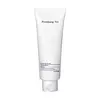What's inside
What's inside
 Key Ingredients
Key Ingredients

No key ingredients
 Benefits
Benefits

 Concerns
Concerns

 Ingredients Side-by-side
Ingredients Side-by-side

Saposhnikovia Divaricata Root Extract
AntimicrobialGlycerin
HumectantMyristic Acid
CleansingLauric Acid
CleansingPotassium Hydroxide
BufferingWater
Skin ConditioningPalmitic Acid
EmollientStearic Acid
CleansingGlycol Distearate
EmollientGlyceryl Stearate
EmollientGlyceryl Stearate Se
EmulsifyingPEG-100 Stearate
1,2-Hexanediol
Skin ConditioningButylene Glycol
HumectantGlyceryl Caprylate
EmollientOzokerite
Emulsion StabilisingHydrogenated Vegetable Oil
EmollientBeeswax
Emulsion StabilisingSodium Chloride
MaskingStearyl Stearate
EmollientHydrogenated Palm Acid
Capric Acid
CleansingOleic Acid
EmollientSodium Polyacrylate
AbsorbentCocamidopropyl Betaine
CleansingParfum
MaskingLinalool
PerfumingLimonene
PerfumingSaposhnikovia Divaricata Root Extract, Glycerin, Myristic Acid, Lauric Acid, Potassium Hydroxide, Water, Palmitic Acid, Stearic Acid, Glycol Distearate, Glyceryl Stearate, Glyceryl Stearate Se, PEG-100 Stearate, 1,2-Hexanediol, Butylene Glycol, Glyceryl Caprylate, Ozokerite, Hydrogenated Vegetable Oil, Beeswax, Sodium Chloride, Stearyl Stearate, Hydrogenated Palm Acid, Capric Acid, Oleic Acid, Sodium Polyacrylate, Cocamidopropyl Betaine, Parfum, Linalool, Limonene
Water
Skin ConditioningGlycerin
HumectantSodium Cocoyl Glycinate
CleansingSodium Lauroyl Glutamate
Sodium Hyaluronate
HumectantHyaluronic Acid
HumectantHydrolyzed Hyaluronic Acid
HumectantSodium Acetylated Hyaluronate
HumectantHydroxypropyltrimonium Hyaluronate
Hydrolyzed Sodium Hyaluronate
Skin ConditioningSodium Hyaluronate Crosspolymer
HumectantPotassium Hyaluronate
Skin ConditioningPanthenol
Skin ConditioningAllantoin
Skin ConditioningTrehalose
HumectantTocopherol
AntioxidantHamamelis Virginiana Extract
AntiseborrhoeicCamellia Sinensis Leaf Extract
AntimicrobialChamomilla Recutita Extract
Skin ConditioningButylene Glycol
HumectantDipropylene Glycol
HumectantHydroxypropyl Starch Phosphate
Glyceryl Stearate Se
EmulsifyingPotassium Benzoate
PreservativeSodium Chloride
MaskingPolyquaternium-67
Sodium Acetate
Buffering1,2-Hexanediol
Skin ConditioningCitric Acid
BufferingEthylhexylglycerin
Skin ConditioningDisodium EDTA
Malachite Extract
AntioxidantWater, Glycerin, Sodium Cocoyl Glycinate, Sodium Lauroyl Glutamate, Sodium Hyaluronate, Hyaluronic Acid, Hydrolyzed Hyaluronic Acid, Sodium Acetylated Hyaluronate, Hydroxypropyltrimonium Hyaluronate, Hydrolyzed Sodium Hyaluronate, Sodium Hyaluronate Crosspolymer, Potassium Hyaluronate, Panthenol, Allantoin, Trehalose, Tocopherol, Hamamelis Virginiana Extract, Camellia Sinensis Leaf Extract, Chamomilla Recutita Extract, Butylene Glycol, Dipropylene Glycol, Hydroxypropyl Starch Phosphate, Glyceryl Stearate Se, Potassium Benzoate, Sodium Chloride, Polyquaternium-67, Sodium Acetate, 1,2-Hexanediol, Citric Acid, Ethylhexylglycerin, Disodium EDTA, Malachite Extract
 Reviews
Reviews

Ingredients Explained
These ingredients are found in both products.
Ingredients higher up in an ingredient list are typically present in a larger amount.
1,2-Hexanediol is a synthetic liquid and another multi-functional powerhouse.
It is a:
- Humectant, drawing moisture into the skin
- Emollient, helping to soften skin
- Solvent, dispersing and stabilizing formulas
- Preservative booster, enhancing the antimicrobial activity of other preservatives
Butylene Glycol (or BG) is used within cosmetic products for a few different reasons:
Overall, Butylene Glycol is a safe and well-rounded ingredient that works well with other ingredients.
Though this ingredient works well with most skin types, some people with sensitive skin may experience a reaction such as allergic rashes, closed comedones, or itchiness.
Learn more about Butylene GlycolGlycerin is already naturally found in your skin. It helps moisturize and protect your skin.
A study from 2016 found glycerin to be more effective as a humectant than AHAs and hyaluronic acid.
As a humectant, it helps the skin stay hydrated by pulling moisture to your skin. The low molecular weight of glycerin allows it to pull moisture into the deeper layers of your skin.
Hydrated skin improves your skin barrier; Your skin barrier helps protect against irritants and bacteria.
Glycerin has also been found to have antimicrobial and antiviral properties. Due to these properties, glycerin is often used in wound and burn treatments.
In cosmetics, glycerin is usually derived from plants such as soybean or palm. However, it can also be sourced from animals, such as tallow or animal fat.
This ingredient is organic, colorless, odorless, and non-toxic.
Glycerin is the name for this ingredient in American English. British English uses Glycerol/Glycerine.
Learn more about GlycerinGlyceryl Stearate Se is a self-emulsifying (SE) form of glyceryl stearate. Self-emusifying means this ingredient automatically blends with water. It is an emulsifier, emollient, and cleansing agent.
As an emulsifier, Glyceryl Stearate Se prevents ingredients such as oil and water from separating. It is also a surfactant, meaning it helps cleanse the skin. Surfactants help gather oil, dirt, and other pollutants so they may be rinsed away easily.
Emollients help your skin stay smooth and soft. It does so by creating a film on top of the skin that helps trap moisture in.
Learn more about Glyceryl Stearate SeChances are, you eat sodium chloride every day. Sodium Chloride is also known as table salt.
This ingredient has many purposes in skincare: thickener, emulsifier, and exfoliator.
You'll most likely find this ingredient in cleansers where it is used to create a gel-like texture. As an emulsifier, it also prevents ingredients from separating.
There is much debate on whether this ingredient is comedogenic. The short answer - comedogenic ratings don't tell the whole story. Learn more about comegodenic ratings here.
The concensus about this ingredient causing acne seems to be divided. Research is needed to understand if this ingredient does cause acne.
Scrubs may use salt as the primary exfoliating ingredient.
Learn more about Sodium ChlorideWater. It's the most common cosmetic ingredient of all. You'll usually see it at the top of ingredient lists, meaning that it makes up the largest part of the product.
So why is it so popular? Water most often acts as a solvent - this means that it helps dissolve other ingredients into the formulation.
You'll also recognize water as that liquid we all need to stay alive. If you see this, drink a glass of water. Stay hydrated!
Learn more about Water